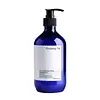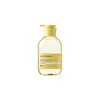What's inside
What's inside
 Key Ingredients
Key Ingredients

 Benefits
Benefits

 Concerns
Concerns

 Ingredients Side-by-side
Ingredients Side-by-side

Water
Skin ConditioningLauryl Glucoside
CleansingDisodium Cocoamphodiacetate
CleansingSodium Chloride
MaskingLauryl Betaine
CleansingGlycerin
HumectantCoco-Betaine
CleansingCitric Acid
BufferingButylene Glycol
HumectantCaprylyl Glycol
EmollientHydroxyacetophenone
AntioxidantPentylene Glycol
Skin ConditioningDipropylene Glycol
HumectantHippophae Rhamnoides Fruit Extract
Skin ConditioningButyrospermum Parkii Butter Extract
Skin ConditioningDisodium EDTA
Ethylhexylglycerin
Skin ConditioningHexylene Glycol
EmulsifyingTocopherol
Antioxidant1,2-Hexanediol
Skin ConditioningCentella Asiatica Extract
CleansingPolyglyceryl-10 Myristate
Skin ConditioningPolygonum Cuspidatum Root Extract
AntioxidantScutellaria Baicalensis Root Extract
AstringentMacadamia Ternifolia Seed Oil
EmollientMineral Salts
Skin ConditioningOlea Europaea Fruit Oil
MaskingLonicera Japonica Flower Extract
Skin ConditioningCamellia Sinensis Leaf Extract
AntimicrobialGlycyrrhiza Uralensis Root Extract
Skin ConditioningHelianthus Annuus Seed Oil
EmollientEthylhexyl Palmitate
EmollientChamomilla Recutita Flower Extract
MaskingCaprylic/Capric Triglyceride
MaskingCetyl Ethylhexanoate
EmollientRosmarinus Officinalis Leaf Extract
AntimicrobialSodium Hyaluronate
HumectantHydrogenated Lecithin
EmulsifyingCeramide NP
Skin ConditioningHydrolyzed Hyaluronic Acid
HumectantHydroxypropyltrimonium Hyaluronate
Sodium Hyaluronate Crosspolymer
HumectantSodium Acetylated Hyaluronate
HumectantWater, Lauryl Glucoside, Disodium Cocoamphodiacetate, Sodium Chloride, Lauryl Betaine, Glycerin, Coco-Betaine, Citric Acid, Butylene Glycol, Caprylyl Glycol, Hydroxyacetophenone, Pentylene Glycol, Dipropylene Glycol, Hippophae Rhamnoides Fruit Extract, Butyrospermum Parkii Butter Extract, Disodium EDTA, Ethylhexylglycerin, Hexylene Glycol, Tocopherol, 1,2-Hexanediol, Centella Asiatica Extract, Polyglyceryl-10 Myristate, Polygonum Cuspidatum Root Extract, Scutellaria Baicalensis Root Extract, Macadamia Ternifolia Seed Oil, Mineral Salts, Olea Europaea Fruit Oil, Lonicera Japonica Flower Extract, Camellia Sinensis Leaf Extract, Glycyrrhiza Uralensis Root Extract, Helianthus Annuus Seed Oil, Ethylhexyl Palmitate, Chamomilla Recutita Flower Extract, Caprylic/Capric Triglyceride, Cetyl Ethylhexanoate, Rosmarinus Officinalis Leaf Extract, Sodium Hyaluronate, Hydrogenated Lecithin, Ceramide NP, Hydrolyzed Hyaluronic Acid, Hydroxypropyltrimonium Hyaluronate, Sodium Hyaluronate Crosspolymer, Sodium Acetylated Hyaluronate
Water
Skin ConditioningSodium Laureth Sulfate
CleansingCocamidopropyl Betaine
CleansingAmmonium Lauryl Sulfate
CleansingParfum
MaskingSodium Chloride
MaskingSorbitol
HumectantSodium Benzoate
MaskingLimonene
PerfumingCaprylyl Glycol
EmollientPhenoxyethanol
PreservativeLinalool
PerfumingCitric Acid
BufferingPolyquaternium-10
Disodium EDTA
Ethylhexylglycerin
Skin ConditioningHexyl Cinnamal
PerfumingButylene Glycol
HumectantCitrus Limon Peel Oil
MaskingShale Extract
EmollientBellis Perennis Flower Extract
Skin ConditioningPulmonaria Officinalis Extract
AstringentCitrus Limon Peel Extract
EmollientTocopherol
AntioxidantWater, Sodium Laureth Sulfate, Cocamidopropyl Betaine, Ammonium Lauryl Sulfate, Parfum, Sodium Chloride, Sorbitol, Sodium Benzoate, Limonene, Caprylyl Glycol, Phenoxyethanol, Linalool, Citric Acid, Polyquaternium-10, Disodium EDTA, Ethylhexylglycerin, Hexyl Cinnamal, Butylene Glycol, Citrus Limon Peel Oil, Shale Extract, Bellis Perennis Flower Extract, Pulmonaria Officinalis Extract, Citrus Limon Peel Extract, Tocopherol
Ingredients Explained
These ingredients are found in both products.
Ingredients higher up in an ingredient list are typically present in a larger amount.
Butylene Glycol (or BG) is used within cosmetic products for a few different reasons:
Overall, Butylene Glycol is a safe and well-rounded ingredient that works well with other ingredients.
Though this ingredient works well with most skin types, some people with sensitive skin may experience a reaction such as allergic rashes, closed comedones, or itchiness.
Learn more about Butylene GlycolCaprylyl Glycol is a humectant and emollient, meaning it attracts and preserves moisture.
It is a common ingredient in many products, especially those designed to hydrate skin. The primary benefits are retaining moisture, skin softening, and promoting a healthy skin barrier.
Though Caprylyl Glycol is an alcohol derived from fatty acids, it is not the kind that can dry out skin.
This ingredient is also used as a preservative to extend the life of products. It has slight antimicrobial properties.
Learn more about Caprylyl GlycolCitric Acid is an alpha hydroxy acid (AHA) naturally found in citrus fruits like oranges, lemons, and limes.
Like other AHAs, citric acid can exfoliate skin by breaking down the bonds that hold dead skin cells together. This helps reveal smoother and brighter skin underneath.
However, this exfoliating effect only happens at high concentrations (20%) which can be hard to find in cosmetic products.
Due to this, citric acid is usually included in small amounts as a pH adjuster. This helps keep products slightly more acidic and compatible with skin's natural pH.
In skincare formulas, citric acid can:
While it can provide some skin benefits, research shows lactic acid and glycolic acid are generally more effective and less irritating exfoliants.
Most citric acid used in skincare today is made by fermenting sugars (usually from molasses). This synthetic version is identical to the natural citrus form but easier to stabilize and use in formulations.
Read more about some other popular AHA's here:
Learn more about Citric AcidDisodium EDTA plays a role in making products more stable by aiding other preservatives.
It is a chelating agent, meaning it neutralizes metal ions that may be found in a product.
Disodium EDTA is a salt of edetic acid and is found to be safe in cosmetic ingredients.
Learn more about Disodium EDTAEthylhexylglycerin (we can't pronounce this either) is commonly used as a preservative and skin softener. It is derived from glyceryl.
You might see Ethylhexylglycerin often paired with other preservatives such as phenoxyethanol. Ethylhexylglycerin has been found to increase the effectiveness of these other preservatives.
Chances are, you eat sodium chloride every day. Sodium Chloride is also known as table salt.
This ingredient has many purposes in skincare: thickener, emulsifier, and exfoliator.
You'll most likely find this ingredient in cleansers where it is used to create a gel-like texture. As an emulsifier, it also prevents ingredients from separating.
There is much debate on whether this ingredient is comedogenic. The short answer - comedogenic ratings don't tell the whole story. Learn more about comegodenic ratings here.
The concensus about this ingredient causing acne seems to be divided. Research is needed to understand if this ingredient does cause acne.
Scrubs may use salt as the primary exfoliating ingredient.
Learn more about Sodium ChlorideTocopherol (also known as Vitamin E) is a common antioxidant used to help protect the skin from free-radicals and strengthen the skin barrier. It's also fat soluble - this means our skin is great at absorbing it.
Vitamin E also helps keep your natural skin lipids healthy. Your lipid skin barrier naturally consists of lipids, ceramides, and fatty acids. Vitamin E offers extra protection for your skin’s lipid barrier, keeping your skin healthy and nourished.
Another benefit is a bit of UV protection. Vitamin E helps reduce the damage caused by UVB rays. (It should not replace your sunscreen). Combining it with Vitamin C can decrease sunburned cells and hyperpigmentation after UV exposure.
You might have noticed Vitamin E + C often paired together. This is because it is great at stabilizing Vitamin C. Using the two together helps increase the effectiveness of both ingredients.
There are often claims that Vitamin E can reduce/prevent scarring, but these claims haven't been confirmed by scientific research.
Learn more about TocopherolWater. It's the most common cosmetic ingredient of all. You'll usually see it at the top of ingredient lists, meaning that it makes up the largest part of the product.
So why is it so popular? Water most often acts as a solvent - this means that it helps dissolve other ingredients into the formulation.
You'll also recognize water as that liquid we all need to stay alive. If you see this, drink a glass of water. Stay hydrated!
Learn more about Water